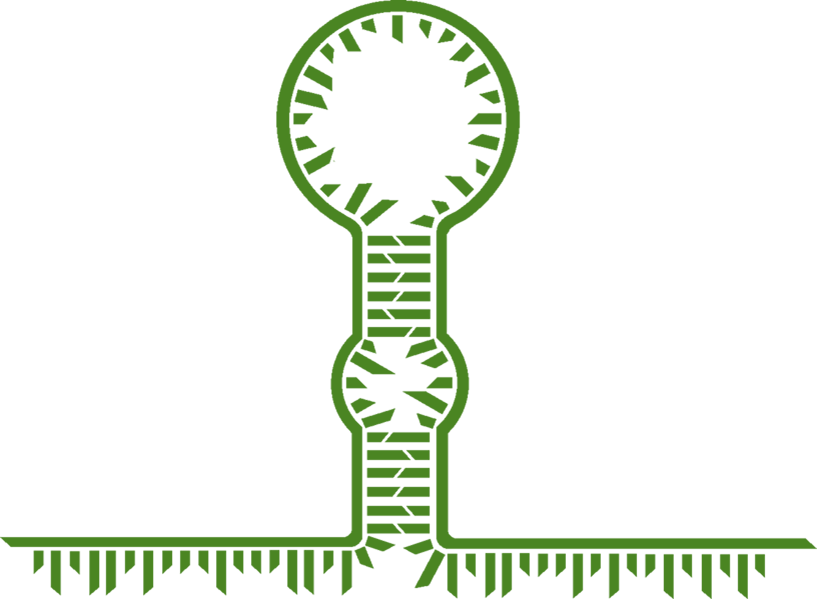Difference between revisions of "Team:Exeter/RNA Riboswitches"
| Line 172: | Line 172: | ||
<p> | <p> | ||
| − | Riboswitches are essentially mRNA molecules which have a regulatory section which controls whether or not the protein coding section is read or not. There are quite a few different types of riboswitches, each with different mechanisms. In general, the presence | + | Riboswitches are essentially mRNA molecules which have a regulatory section which controls whether or not the protein coding section is read or not. There are quite a few different types of riboswitches, each with different mechanisms. In general, the presence or absence of a trigger (from small metal ions, amino acids, proteins and other RNA molecules), or changes in conditions such as temperature and pH, causes a change in conformation of the riboswitch which then either allows or stops the protein coding region from being read by a ribosome and the protein produced. Broadly, riboswitches can be put into two groups; those which act at the transcriptional level, and those at the translational level. This section will describe the general mechanisms of each type. |
</p> | </p> | ||
Revision as of 01:11, 19 September 2015
Toehold Background
For more fundamental background information, click here.
Riboswitches
Riboswitches are essentially mRNA molecules which have a regulatory section which controls whether or not the protein coding section is read or not. There are quite a few different types of riboswitches, each with different mechanisms. In general, the presence or absence of a trigger (from small metal ions, amino acids, proteins and other RNA molecules), or changes in conditions such as temperature and pH, causes a change in conformation of the riboswitch which then either allows or stops the protein coding region from being read by a ribosome and the protein produced. Broadly, riboswitches can be put into two groups; those which act at the transcriptional level, and those at the translational level. This section will describe the general mechanisms of each type.
Transcriptional Control:
One of the main types of riboswitches controls the production of its own mRNA. During transcription, the riboswitch section of the mRNA is produced first while the rest of the coding section is being synthesised. This regulatory section is able to take on one of two structures depending on the presence/absence of a ligand/change in conditions. If the riboswitch is turned off by the conditions/ligand presence, then it will cause a terminator to form in the mRNA and hence the RNA polymerase will stop transcription before the entire mRNA is produced, resulting in an essentially useless mRNA molecule. However, if the riboswitch is turned on, then an antiterminator is formed instead and the RNA polymerase is able to read through the entire mRNA and allow the protein to be expressed (Figure 1).
Translational control:
Riboswitches which act at the translational level usually work by sequestering the RBS (ribosome binding site) away from the ribosome, and hence stop translation of the mRNA and protein production. There are different mechanisms of sequestering and revealing the RBS. One of these ways is through cleavage of the riboswitch. In the absence/presence of a certain ligand/condition, the riboswitch can take on a conformation in which a cleavage site is revealed. If the riboswitch becomes cleaved, then the RBS can be released and accessed by a ribosome, which can then read the protein coding region of the mRNA. The cleavage of this riboswitch can be carried out by a protein/ribozyme, or in some cases by the riboswitch itself. Another way in which an RBS can be sequestered is by being placed within a loop structure. When in a loop structure, the ribosome is unable to bind to the RBS sequence, and hence the protein can't be produced. If a ligand/condition changes the conformation of the riboswitch causing the loop structure to be removed, then the ribosome becomes able to bind to the RBS and read the rest of the mRNA (Figure 2).
Other types of riboswitches:
There are many types of riboswitches which are found in nature, each with a different type of mechanism. Our project is based around a specific riboswitch called a toehold switch. In the next section, the use of riboswitches in synthetic biology will be discussed in addition to a description of the structure and mechanism of a toehold switch.
Natural and Synthetic Toehold Switches
As has been discussed in the previous sections, RNA is an important molecule which is involved in many functions, including cellular regulation. Discussed in some detail in the previous section were riboswitches and the different types and mechanisms of action. For our project we have designed and improved upon a specific type of riboswitch; a toehold switch. Toehold switches are riboswitches which regulate at the transcriptional level via RBS sequestration, and they are so named for the toehold structure which is an integral part of the riboswitch (figure 3). The basic mechanism of action is that an RNA molecule with a complementary sequence to that of the switch region of the toehold switch binds to the switch and causes the structure to open up, removing the toehold structure and revealing the RBS to allow the ribosome to bind. This mechanism is discussed in further detail below.





